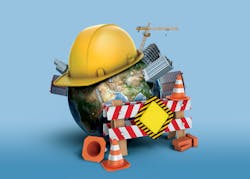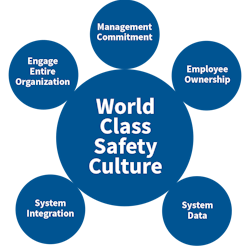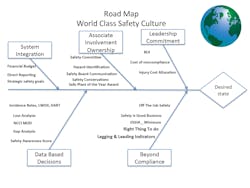Actively Engaging Employees Using Five Pillars of Safety
Safety culture is the shared beliefs, experiences, attitudes and passions of a group of people. A world-class safety culture in a work environment is a way of life and a belief to send all employees safely back home every day—and in the process, help the company make money, showing to senior executives that safety makes good business sense. It is an outstanding safety culture that proactively manages employee and business safety decision-making. It is an environment that allows management and employees to make decisions based on what is the right thing to do both for safety and running the business. If you do the right thing, money will flow. Business will run profitably.
World-class safety is like beauty. It is difficult to describe but you know it when you see it. At one of the printing plants with which I was associated, the ventilation system broke down in the ink room. Rather than continue to run the ink mixing operation that created a lot of vapors, the GM shut down the printing operation until the ventilation system was fixed. That is a world-class safety culture.
At another plant, the company CEO walked into the manufacturing operation that had a safety shoe requirement in place. An employee came to the CEO and asked if he had safety shoes. He said, “No.” The employee said, “Then you can’t be in the plant until you have safety shoes on.” The CEO was stunned but he went and bought new safety shoes before entering the manufacturing operation. Companies with world-class safety culture empower their employees to do the right thing without fear.
In order to be a successful safety professional in a world-class company you need to have passion for safety and missionary zeal—a clear-cut vision and a mission. As a safety director, my vision and mission was to send every employee back to his or her family safe and sound every day. My secondary mission and equally important to me was to show to management that safety makes good business sense. This made me motivated every day and kept me awake every night. I wanted my company to have a world-class safety culture.
In order to achieve the top level of safety performance you need to have a safety process, an organized approach, in place. You need to constantly evaluate your process and make necessary adjustments necessary for success. My safety process was the Five Pillars of Safety (Figure 1). Before you can achieve improvement in safety it is important to complete a gap analysis analyzing the gap you have between where you are and where you want to go. You need to identify your company’s Current State as regards safety and define your Desired State and put in place a road map to bridge the gap within the confines of your safety process.
A road map is a plan or strategy intended to achieve a particular goal. In my office I had a sculpture with world-class safety supported on the five pillars constantly reminding me of my goal and process. I had a diagram of my road map showing the five pillars and what has been accomplished, what is being accomplished and what needs to be accomplished (Figure 2). It was a constant reminder of the safety process and where we were in the process.
It is very important that you have a safety process in place to manage your safety initiatives. I suggest you use these Five Pillars of Safety as your process to manage your safety initiatives. The five pillars are:
• Management Leadership and Commitment,
• Employee Involvement and Ownership,
• Data-based Decision-Making and System-based Root Cause,
• Going Beyond Compliance,
• System Integration with Business Functions.
SAFETY IS GOOD BUSINESSWorld-class companies get all of their employees actively engaged in safety. This includes senior executive, managers, supervisors, production employees, support employees and even your customers visiting your plants. But how do you do that?
I was able to get senior management’s active engagement by pointing out the financial benefits from safety initiatives. Profit and absence of a loss is a big motivator for senior executives. Every day they look at the balance sheets and talk about it. We should talk about how our work positively impacts the bottom line. We saved more than a million dollars and I showed them how we did that by using insurance company loss and premium information. Using the NCCI MOD rates I was able to show significant premium savings as a result of company safety efforts.
I would complete a safety audit calculating fines as if I was the OSHA guy. Every safety violation complied with is savings of a potential OSHA fine.
I would complete return on investment calculations to show the benefits of safety improvements. We had significant ergonomic issues and I wanted the company to install an automatic vacuum system. I showed them how the ROI was above the company’s hurdle rate. I would analyze losses by locations and show which plants needed more attention to control injuries, showing efficient use of company resources.
You need to talk management’s language because they may not hear or understand the safety language. Combine safety and finance. You will get them to hear what you are saying and be a partner with you in getting to achieve your safety initiatives.
GETTING THE WHOLE TEAM INVOLVED
As safety director I was able to get other employees actively engaged by developing roles and responsibilities. Once people understand what their role is in the overall picture, they tend to take it to heart and fulfill those responsibilities. For example, the role of a production employee was to check their area of operation for safety every day. They took this responsibility very seriously, and in the process, the work area and surroundings became safer to work as they got actively engaged in safety.
Another program was the Safety Board Program (different than the Safety Communication Board). It required each department to prepare the safety board every quarter. These boards showed such things as lift truck safety, chemical safety, lockout/tagout, etc. These educational boards were put together by the production employees. The winning team was awarded a free lunch at the end of the year. They got very engaged in safety, learned a lot about safety and took pride of their work.
Every month we would have monthly phone conversations with safety champions from each plant, sharing best practices and helping all of us grow to the highest level of safety awareness. We would invite subject matter experts to discuss things like legal liability and workers compensation laws training and educating the leaders.
We required that the managers and supervisors at each plant should carry an OSHA 10-Hour Card. As a result, each of them was aware of the OSHA safety standards and proactively controlled the exposures and violations.
Plant employees were encouraged to join safety committees and offered suggestions to improve plant safety. We would catch employees doing the right thing and posted their pictures showing that activity. We found they all wanted to do the right thing in the hope of being caught doing right things.
We conducted employee surveys asking their feedback and posted all their responses for everyone to see. Amazing things happen when you are honest. Good things happen—people become safe and happy.
Companies spend millions of dollars collecting data so executive decisions are correct in guiding the company to accomplishing its goals and objectives. Executives manage their companies based on what the data is saying. As safety professionals we need to develop and collect data to manage the safety system in an intelligent way. Also by managing the safety system using meaningful data, you are aligning safety with the company in the way the company is being managed. You can use various kinds of data to measure the effectiveness of your safety system. This data can help you determine the effectiveness of your safety system and where it needs to be improved.
BEYOND COMPLIANCE
World-class safety companies go beyond what is required by law. OSHA and EPA requirements should be the minimum. As safety professionals you should actively identify where you can excel in going beyond.
We had a sustainability program asking and encouraging employees to control and manage waste. We had seat belt usage patrols in our parking lot checking to see if employees were wearing seat belts or not. This encouraged our employees to wear seat belts and protect themselves when they are on their own driving.
We distributed safety and wellness fact sheets for our employees to encourage them to live a more productive life. We put together a business continuity plan to protect the business operation in case of a disaster. We encouraged our employees to be safe at home by asking them to complete home fire evacuation plans. You have to have your people think about safety even when they’re not at work.
World-class companies think about safety on a larger context and not just safety at work. It is also important that there is systemic integration of safety and business functions. Safety should be a critical business function.
Michael Saujani, CSP, CPCU, ARM is CEO of MKS Safety, a loss control consulting firm. He is author of the book, How to Cultivate World-Class Safety Culture: Actively Engaging Employees Using the Five Pillars of Safety. He was previously corporate safety director at Fort Dearborn Company.
About the Author
Michael Saujani
Michael Saujani, CSP, CPCU, ARM is CEO of MKS Safety, a loss control consulting firm. He is author of the book, How to Cultivate World-Class Safety Culture: Actively Engaging Employees Using the Five Pillars of Safety. He was previously corporate safety director at Fort Dearborn Company.


